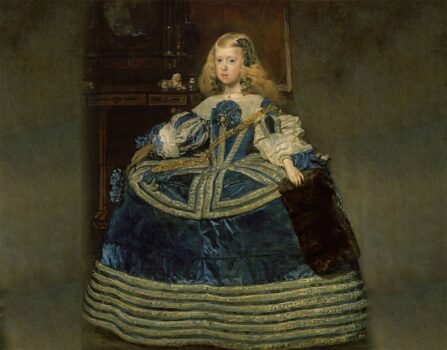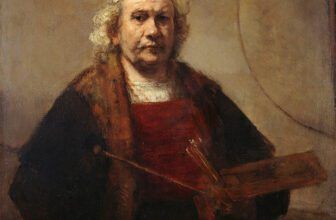What are Diego Velázquez Famous Paintings
In the grand tapestry of European art, few names command the same reverence and awe as Diego Rodríguez de Silva y Velázquez. Born in the early 17th century in Seville, Spain, Velázquez carved a place for himself in history not only as a painter of exceptional skill but as an observer of the human soul. His paintings breathe with a realism and immediacy that transcends centuries, capturing not just images, but the very essence of his subjects.
Whether standing in front of the imposing “Las Meninas” at the Prado Museum or admiring the stark humanity of “The Waterseller of Seville,” one thing becomes abundantly clear: Diego Velázquez wasn’t just a painter of kings, he was a king of painters.
A Talent Rooted in Seville
Velázquez was born on June 6, 1599, in Seville, Spain, into a middle-class family. His early education included studies in languages and philosophy, but it was in art that he found his calling. By the age of 11, he was apprenticed to Francisco Pacheco, a local painter and art theorist. While Pacheco’s style was conservative, he offered young Velázquez something even more valuable: access to the literary and artistic circles of Seville and the hand of his daughter Juana, whom Velázquez would later marry.
During his formative years, Velázquez developed a keen interest in naturalism and tenebrism, a style made famous by Caravaggio. His early paintings show a mastery of light and shadow, creating depth and emotional resonance. Works like “Old Woman Frying Eggs” (1618) and “The Waterseller of Seville” (c. 1620) showcase Velázquez’s fascination with everyday life, elevating the mundane to the sublime.
Summoned to the Court: The Royal Portraitist
Velázquez’s true rise to fame came in 1623, when he was invited to Madrid and appointed court painter to King Philip IV of Spain. At just 24, Velázquez was tasked with painting one of the most powerful monarchs in Europe. This marked the beginning of a lifelong relationship with the Spanish crown.
He painted Philip IV over 30 times, capturing the king not just as a sovereign, but as a man weighed down by the burden of power. His royal portraits were celebrated for their psychological depth and dignity, eschewing flamboyance for solemn grandeur. “Philip IV in Brown and Silver” (1631–32) is a prime example, elegant, restrained, and deeply introspective.
During his court years, Velázquez also painted members of the royal family, court jesters, dwarfs, and visiting dignitaries. In each work, regardless of the subject’s social standing, he portrayed the subject with humanity and respect. This egalitarian approach was revolutionary for the time.
Famous Paintings by Diego Velázquez
Velázquez’s catalog is rich and varied, but a few masterpieces stand out as defining works in art history.
1. Las Meninas (1656)
Arguably his most famous painting, “Las Meninas” (The Maids of Honour) is a complex, enigmatic, and deeply innovative composition. It depicts the young Infanta Margarita Teresa surrounded by her entourage, including her ladies-in-waiting, a dwarf, a dog, and Velázquez himself, standing behind a large canvas.
What makes “Las Meninas” so remarkable is its sophisticated play with perspective and viewer engagement. In the mirror on the back wall, we see the reflection of King Philip IV and Queen Mariana, suggesting they might be the ones being painted. But Velázquez includes himself in the act of painting, was he painting the royal couple, the infanta, or us, the viewers?
The painting is considered one of the most analyzed artworks in history, inspiring generations of artists and thinkers, including Pablo Picasso, who created an entire series based on it.
2. The Surrender of Breda (1634–35)
Also known as “Las Lanzas,” this historical painting commemorates the 1625 surrender of the Dutch city of Breda during the Eighty Years’ War. Rather than glorify war, Velázquez presents a moment of chivalric grace, the Dutch commander Justinus van Nassau hands the keys of the city to the Spanish general Ambrosio Spinola with dignity and mutual respect.
The composition, detail, and emotional gravity of the painting make it a masterpiece of political and human storytelling.
3. The Rokeby Venus (1647–1651)
This is Velázquez’s only surviving nude and a masterclass in sensuality and subtlety. The Rokeby Venus (named after the Rokeby Park estate in England, where it was once housed) depicts the Roman goddess Venus reclining and looking into a mirror held by Cupid.
In an era when the Catholic Church disapproved of nudity in art, Velázquez’s choice was bold. The softness of the form, the psychological ambiguity of the reflected gaze, and the sheer technical brilliance make it one of the most beautiful nudes in Western art.
4. The Triumph of Bacchus (1628–29)
Commonly known as “Los Borrachos” (The Drunks), this work blends classical mythology with real-world Spanish peasants. Bacchus, the god of wine, crowns a mortal surrounded by intoxicated companions. It’s a joyful yet grounded depiction that juxtaposes divine myth with human revelry.
5. Portrait of Innocent X (1650)
Painted during his second trip to Italy, this is widely considered one of the greatest portraits ever made. The pope’s stern, penetrating gaze, captured with masterful realism, conveys immense psychological depth. So powerful is the portrait that Francis Bacon created a whole series of paintings inspired by it in the 20th century.
How Many Paintings Did Velázquez Create?
Art historians estimate that Diego Velázquez produced around 120–130 known paintings, though some are disputed or lost. Unlike many of his contemporaries, Velázquez was highly selective and deliberate in his output. He didn’t produce vast numbers of works, but what survives is of consistently exceptional quality.
Where Are Velázquez’s Paintings Today?
The Prado Museum in Madrid is the primary guardian of Velázquez’s legacy. It houses over 40 of his works, including “Las Meninas,” “The Surrender of Breda,” and many royal portraits.
Other significant locations include:
National Gallery, London – “The Rokeby Venus”
Museo de Arte de São Paulo – “Portrait of a Young Man”
Metropolitan Museum of Art, New York – several works including “Juan de Pareja”
Museo del Louvre, Paris – various religious works
Galleria Doria Pamphilj, Rome – “Portrait of Innocent X”
What is Diego Velázquez Known For?
Velázquez is celebrated as one of the founders of modern realism. His ability to render lifelike images with minimal brushwork was centuries ahead of its time. He was a pioneer of:
Psychological portraiture – capturing the inner life of his subjects
Naturalism – showing people as they were, not idealized
Complex composition – especially in group scenes like “Las Meninas”
Loose, suggestive brushwork – a precursor to impressionism
He influenced not just Spanish art, but European painting as a whole. His legacy can be felt in the works of Goya, Manet, Picasso, and even modern realists today.
What is the Most Expensive Painting by Velázquez?
While most of Velázquez’s masterpieces are in public museums and thus not for sale, the “Portrait of Juan de Pareja” (1650), once owned privately and acquired by the Metropolitan Museum of Art in 1971, became the most expensive painting ever purchased at the time, selling for over $5.5 million (about $38 million today, adjusted for inflation).
Because of his limited body of work and immense historical value, Velázquez’s paintings are virtually priceless today. Were “Las Meninas” ever to go on the market (which is highly unlikely), it could easily fetch hundreds of millions of dollars, if not more.
The Legacy of Diego Velázquez
Velázquez died on August 6, 1660, just a few days after being knighted into the prestigious Order of Santiago, a rare honor for someone not of noble birth. The red cross of the order appears in “Las Meninas,” though it was likely added posthumously to honor him.
His legacy is monumental:
Pioneer of Psychological Realism: Velázquez’s ability to capture the psychology of his subjects had a profound influence on portraiture.
Inspiration to Later Artists: Édouard Manet called him “the painter of painters.” Picasso’s reinterpretations of “Las Meninas,” Francis Bacon’s grotesque popes, and Salvador Dalí’s surreal homages all trace back to Velázquez.
Humanist Vision: His ability to humanize all subjects, from kings to court dwarfs, left a legacy of dignity in representation.
Even now, over 350 years after his death, Velázquez continues to be studied, imitated, and admired.
A Painter Who Looked Beyond the Canvas
What sets Velázquez apart is not merely his technical skill, which was extraordinary, but his deep empathy and intellectual curiosity. He painted not just faces, but souls. He showed kings as men, jesters as thinkers, gods as beings of flesh and blood.
His legacy endures not only in the museums that proudly display his works but in the way artists think about their craft. To paint like Velázquez is to see the world clearly and truthfully, to seek the profound in the ordinary, and to honor the dignity of all humanity.
In the brushstrokes of Velázquez, we find not only the history of Spain but the timeless truth of what it means to be human.




